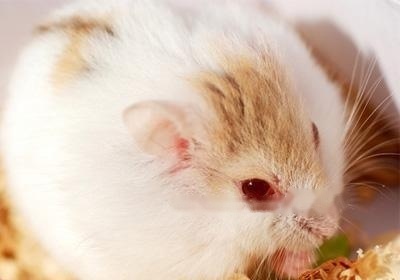
Amber Hamster
Length: 10-12cm
English name: Five eyebrows
Lifetime: 4-6 years
Chipmunks have the habit of storing food and hibernating. Usually, hibernation occurs in the wild environment. It is not necessary to hibernate in captivity in a warm room. Chipmunks are currently mainly distributed in North China, Northwest China, Northeast my country and other places. The fur is of good quality and beautiful.
Chinese name: Chipmunk
Alternative name: Chipmunk, Huali stick, zebraSquirrels, Chipmunks
Kingdom: Animalia
Order: Rodents
Family: Squirrel
Origin: Northeast Asia, Hokkaido
Diet: Plant-based omnivorous
Lifespan: 4~ 6 years
Body length: 14~16cm
Tail length: 13cm
The chipmunk has a pair of chimpanzees, thumbs and horns. It feels very smart, and the slender tail is close to the length of the body. As Squirrels like to climb, which is their specialty. The distinction between male and female mice is relatively simple.
The chipmunk can be easily identified by its five characteristic stripes. The adult chipmunk is about 15cm in length and about 12cm in tail length.
The ancestry of chipmunks can be traced back millions of years. They can live almost anywhere, as long as there are plenty of seeds and soil suitable for burrowing to protect them from many predators.
There are two elastic pockets in the cheeks of the chipmunk - the cheek pockets. The cheek pockets are large enough to hold up to seven acorns, and like carrying a lunch box with them, they can store food in the cheek pockets and take them out for a meal when they are hungry. Chipmunks are very clean animals, always grooming themselves. As winter approaches, fewer chipmunks forage under trees, spending more and more time in their burrows.
The chipmunk will spend five months of winter here, lying in a leafy nest on top of the food, waking up again and again to eat. Males emerge first in the spring, and they end hibernation about two weeks earlier than females. Temperatures are usually above freezing and there is little food around, so they must continue to rely on the food they have stockpiled from the previous summer and fall. Chipmunk breeding season is here, and the males are looking for mates. Chipmunks do not have strict territorial boundaries, and they often walk into neighbors' territory. Each chipmunk offends neighbors many times, which leads to high-speed chases in the woods. After mating is complete, the females drive the males away. After a month, the female mice will give birth to young mice in the ground.
The chipmunk loves to climb. In midsummer, the berries and seeds ripen on the tall branches. It leaves only the seeds, and very skillfully strips the rest of the fruit so that it comes back full.
Since the chipmunk disperses its seeds as widely as possible, it actually plays a meaningful and extremely important role in forest ecology in nature. Doing so will also benefit the offspring of chipmunks.
If you want to keep a healthy and long-lived chipmunk, it is not only about giving them comfort Wo oh, diet is also a big key. In order to express their love for chipmunk, more owners like to feed people's food, so is this kind of feeding advisable? The following is a detailed explanation of the feeding points of chipmunk.
1. The staple food of the diet
The chipmunk is an omnivorous animal and can eat almost everything, but the staple food is all kinds of nuts.
2. Moisture
The chipmunk does not need to drink water. If you want to drink it, remember to boil the water! It must be absolutely clean. Some owners give them vegetables and fruits to get water! Because they are really small, a little water is enough! They love green vegetables, remember that the green vegetables must be rinsed and dried in the wind. Yellow sprouts and cabbage can also be used! But they must be washed! Such as tomatoes, cucumbers, apples and oranges can be eaten by them.
3. About sunflower seeds
There are also various kinds of sunflower seeds, such as sunflower seeds, pumpkin seeds, watermelon seeds, etc. Chipmice loves to eat them Oh.
The chipmunk quite likes to eat sunflower seeds, but the fat content of the sunflower seeds is too high. If the chipmunk eats too much, it will cause obesity, partial eclipse, malnutrition and other problems, so the sunflower seeds can only be used as snacks or cooked For the non-essential items to enhance the relationship, do not feed too much, at most one or two per meal. However, if it is in winter, you can add more heat to the chipmunk to survive the cold winter.
Fourth, inedible food
Although chipmunk is an omnivorous animal, there are still things that cannot be eaten. If you eat it accidentally It can lead to diarrhea in mild cases and death in severe cases, so be careful!!
1. Spicy (irritating) foods
Such as chili, green pepper, onion, garlic, ginger , leeks, nine layers of culture and so on.
2. Kernels such as peach, plum, apple, etc.
It is said that it will cause the chipmunk's heart rate to increase, which may lead to symptoms such as shock. The detailed reason is not very clear, but it is better to believe it and be careful. The potassium ion content of the above things is high, so it is easy to cause the chipmunk to eat too much, tachycardia and death.
3. What people eat
The food that people eat is too oily and salty for chipmunk, which is very harmful to health, especially meat dishes Or other oily snacks should not be eaten by chipmunks!!